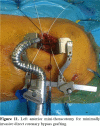Minimal access in cardiac surgery
- PMID: 33403151
- PMCID: PMC7759047
- DOI: 10.5606/tgkdc.dergisi.2020.19614
Minimal access in cardiac surgery
Abstract
Over the past two decades, minimally invasive cardiac surgery has been adopted with the use of endoscopic methods in 1990s and advanced robotic surgery since the early 2000s. In parallel with technological developments, surgical experience has increased and several cardiac operations are able to be performed using different mini-incisions. In this review, we discuss approaches to minimally invasive cardiac surgery, incisions, technical details, and suggestions.
Keywords: Minimally invasive cardiac surgery; surgical approach; surgical incision.
Copyright © 2020, Turkish Society of Cardiovascular Surgery.
Conflict of interest statement
Conflict of Interest: The author declared no conflicts of interest with respect to the authorship and/or publication of this article.
Figures













Similar articles
-
Robotic total thyroidectomy with modified radical neck dissection via unilateral retroauricular approach.Ann Surg Oncol. 2014 Nov;21(12):3872-5. doi: 10.1245/s10434-014-3896-y. Epub 2014 Sep 17. Ann Surg Oncol. 2014. PMID: 25227305
-
Robotically assisted cardiac surgery: minimally invasive techniques to totally endoscopic heart surgery.J Cardiovasc Nurs. 2003 Nov-Dec;18(5):382-8. doi: 10.1097/00005082-200311000-00010. J Cardiovasc Nurs. 2003. PMID: 14680342 Review.
-
Robotic mitral valve surgery.Am J Surg. 2004 Oct;188(4A Suppl):83S-88S. doi: 10.1016/j.amjsurg.2004.08.021. Am J Surg. 2004. PMID: 15476657
-
Robotic mitral valve surgery.Surg Clin North Am. 2003 Dec;83(6):1387-403. doi: 10.1016/S0039-6109(03)00162-2. Surg Clin North Am. 2003. PMID: 14712874 Review.
-
[15 years of minimally invasive paediatric cardiac surgery; development and trends].An Pediatr (Barc). 2016 Jun;84(6):304-10. doi: 10.1016/j.anpedi.2015.06.007. Epub 2015 Jul 26. An Pediatr (Barc). 2016. PMID: 26216279 Spanish.
Cited by
-
Pain Management in Minimally Invasive Cardiac Surgery: A Review of Current Clinical Evidence.Pain Ther. 2025 Jun;14(3):913-930. doi: 10.1007/s40122-025-00739-1. Epub 2025 Apr 24. Pain Ther. 2025. PMID: 40272720 Free PMC article. Review.
-
Theoretical and Practical Aspects in the Use of Bretschneider Cardioplegia.J Cardiovasc Dev Dis. 2022 Jun 2;9(6):178. doi: 10.3390/jcdd9060178. J Cardiovasc Dev Dis. 2022. PMID: 35735807 Free PMC article. Review.
-
Serratus posterior superior intercostal plane block: novel block for minimal invasive cardiac surgery -A report of three cases.Korean J Anesthesiol. 2024 Feb;77(1):166-168. doi: 10.4097/kja.23542. Epub 2023 Oct 18. Korean J Anesthesiol. 2024. PMID: 37852626 Free PMC article. No abstract available.
-
Left subclavian artery obstruction mimicking non-pulsatile flow during minimally invasive cardiac surgery.Indian J Anaesth. 2023 Feb;67(Suppl 2):S143-S144. doi: 10.4103/ija.ija_298_22. Epub 2023 Feb 22. Indian J Anaesth. 2023. PMID: 37122933 Free PMC article. No abstract available.
-
Enhanced Recovery After Cardiac Surgery for Minimally Invasive Valve Surgery: A Systematic Review of Key Elements and Advancements.Medicina (Kaunas). 2025 Mar 13;61(3):495. doi: 10.3390/medicina61030495. Medicina (Kaunas). 2025. PMID: 40142306 Free PMC article.
References
-
- Vanermen H, Farhat F, Wellens F, De Geest R, Degrieck I, Van Praet F, et al. Minimally invasive video-assisted mitral valve surgery: from Port-Access towards a totally endoscopic procedure. J Card Surg. 2000;15:51–60. - PubMed
-
- Benetti FJ, Mariani MA, Rizzardi JL, Benetti I. Minimally invasive aortic valve replacement. J Thorac Cardiovasc Surg. 1997;113:806–807. - PubMed
-
- Cosgrove DM 3rd, Sabik JF, Navia JL. Minimally invasive valve operations. Ann Thorac Surg. 1998;65:1535–1538. - PubMed
Publication types
LinkOut - more resources
Full Text Sources
Miscellaneous
